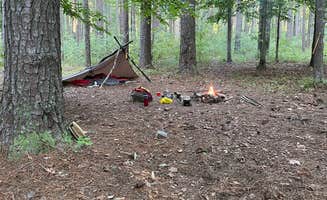Dispersed camping near Millerville, Alabama centers around the eastern portion of the Talladega National Forest where pine and hardwood forests cover rolling terrain with elevations ranging between 600-2,400 feet. The region features numerous small waterfalls, rocky outcroppings, and ridge systems with prominent trails including the Pinhoti, which serves as Alabama's connection to the Appalachian Trail. Camping accessibility varies significantly based on trailhead location and water levels throughout the year.
What to do
Rock climbing opportunities: Several backcountry sites provide access to climbing areas along ridge systems. At Pinhoti Backcountry Campground near Odum Trail, campers can access nearby climbing spots. "Be prepared to do some serious climbing to get up to the ridge though," notes Asher K., who adds that "it's only a short walk to one of the nearby overlooks."
Swimming and water activities: The creek systems provide natural swimming areas during warmer months. "I liked how close it is to the waterfall so you could set up camp and go for a nice evening swim before cooking dinner," writes one reviewer about Chinnabee Silent Trail Backcountry Site 7. Water levels peak in spring and decrease throughout summer.
Trail intersections exploration: The network of interconnected trails allows for various hiking options from most campsites. "This campground is located at a point where the trail splits and either goes to the Lake Chinnabee recreation area or turns and continues on the skyway loop south," explains a camper about one site, noting that "this site sits at the intersection of multiple trails."
What campers like
Privacy levels: Campsites vary in seclusion, with some offering complete isolation from passing hikers. At Chinnabee Silent Trail Backcountry Site 2, Ben W. appreciates that it's "about 50 yards down a side trail so it's nice and private. A few people walked down to see the site but nobody disturbed me."
Stargazing quality: Ridge-top sites provide excellent night sky viewing with minimal light pollution. According to Asher K. who stayed at Skyway Loop Backcountry, "Make sure to spend some time out on the rocks at night since you can see every star in the sky."
Group accommodation: Multiple sites feature expanded camping areas for larger parties. "This is a large site with a nice fire pit perfect for a large group. Someone also conveniently set up logs for sitting on," describes one camper about Pinhoti Backcountry Campground. Another notes a site has "2 fire rings and is big enough for even large groups to spread out."
What you should know
Trail markings: Navigation challenges increase during certain seasons, particularly after leaf fall. "The signage along these trails is also good and they are well traveled though there are a few stream crossings that can get confusing so keep an eye out for turns in the trail, especially in the fall or winter when there are leaves on the ground," advises a camper.
Campsite positioning: Some sites sit directly on trails while others require short detours. "If you are not an early riser be aware that this site is right alongside the trail so you may hear people who get out on the trail in the morning," cautions a reviewer about one backcountry site.
Water sources reliability: Seasonal fluctuations significantly impact water availability. As noted for Pinhoti Backcountry Campground near Odum Intersection, "It is not far from a water source though the water is seasonal and can be very low in winter. Be prepared to not have water for pumping and bring extra in dry times."
Tips for camping with families
Short hike-in options: Several sites offer backcountry experiences with minimal hiking distance. One site is described as having "easy access" where "you can park at Lake Chinnabee and walk a short distance to get to the campsite." This makes it more accessible for families with younger children.
Protected campsites: Look for sites with natural wind barriers for more comfortable family camping. A camper describes one location as "a nice protected area a short way in from the chinnabee silent parking area. It has a nice large flat area for setting up several tents."
Base camp logistics: Some sites work well for establishing a central camp while taking day hikes. At Skyway Loop Backcountry Site Near Chinnabee, Asher K. notes, "If you are a backpacker completing the loop this is a great place to rest and have lunch or this would be a good night option if you do the loop over 3-4 days."
Tips from RVers
Small trailer access: Limited options exist for non-tent camping, with Hollins Hunting Camp offering the main vehicle-accessible sites. At Hollins Hunting Camp, Weather Warrior Media notes, "Small camper trailers could probably make it too. Just be mindful of turn around spots."
Overlanding potential: Rooftop tent and vehicle-based camping works best at specific locations. "Best for overlanding/camper/tents. No marked sites, just pull in and find a spot," shares Peyton P. about Hollins Hunting Camp, while another camper adds "Overlanders (w/rtt) will be the most happy. Open areas have tall grass a bit, but some have enough pine trees the pine needles make for better ground camping."
Arrival timing considerations: Early arrival improves site selection at drive-in areas. One camper mentioned, "I arrived late so harder to find spots," while another noted, "I got in around 8 and there were only a couple people here, lots of space and easy to find a private spot."


